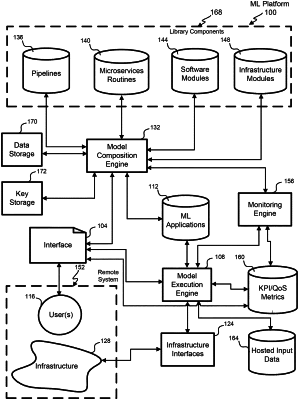| CPC G06F 18/213 (2023.01) [G06F 8/75 (2013.01); G06F 8/77 (2013.01); G06F 11/3003 (2013.01); G06F 11/3409 (2013.01); G06F 11/3433 (2013.01); G06F 11/3452 (2013.01); G06F 11/3466 (2013.01); G06F 16/211 (2019.01); G06F 16/2365 (2019.01); G06F 16/24573 (2019.01); G06F 16/24578 (2019.01); G06F 16/285 (2019.01); G06F 16/367 (2019.01); G06F 16/9024 (2019.01); G06F 16/9035 (2019.01); G06F 16/907 (2019.01); G06F 18/10 (2023.01); G06F 18/2115 (2023.01); G06F 18/2155 (2023.01); G06N 5/01 (2023.01); G06N 5/025 (2013.01); G06N 20/00 (2019.01); G06N 20/20 (2019.01); H04L 9/088 (2013.01); H04L 9/3236 (2013.01)] | 20 Claims |

|
1. A method for automatically creating a machine-learning application for use in a production environment, the method comprising:
receiving an input, wherein the input identifies a problem to be solved using the machine-learning application;
selecting a machine-learning model template from a plurality of templates based at least in part on the input, wherein the machine-learning model template includes metadata, the metadata specifies data expectations and available data formats;
analyzing one or more formats of customer data to generate a customer data schema based at least in part on a data ontology that applies to the identified problem;
determining whether the customer data schema is misaligned with one or more key features of the selected machine-learning model template;
based at least in part on the determination that the customer data schema is misaligned with the one or more key features of the selected model, analyzing the metadata for the selected machine-learning model template to determine what additional information is required to re-align the customer data with the data expectations of the selected machine-learning model template as indicated in the metadata;
gathering the additional information required to re-align the customer data with the data expectations of the selected machine-learning model template;
based at least in part on the additional information, performing one or more remedial actions on the customer data to re-align with the data expectations of the selected machine-learning model template to result in a transformed dataset, wherein a remedial action of the one or more remedial actions comprises rescaling the customer data to fit the data expectations of the selected machine-learning model template, the rescaling of the customer data includes an infrastructure deployment corresponding to one or more micro services architecture in the transformed dataset; and
training the machine-learning application using the selected machine-learning model template and the transformed dataset.
|